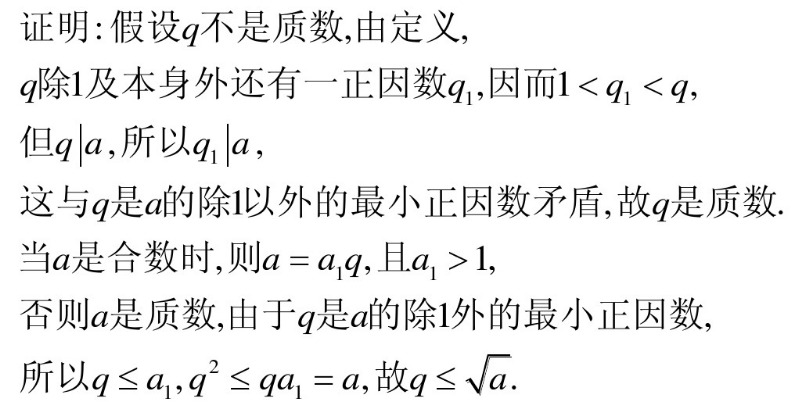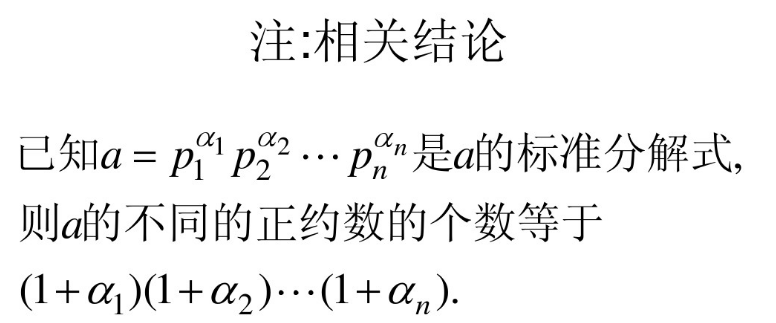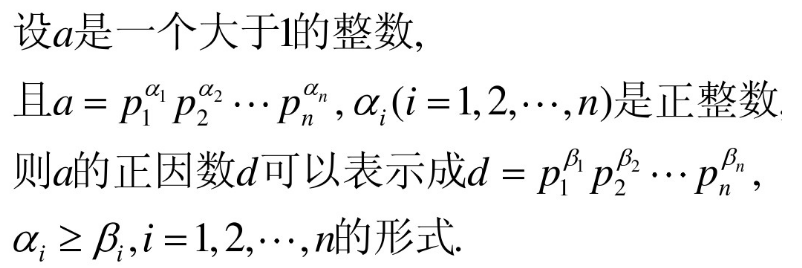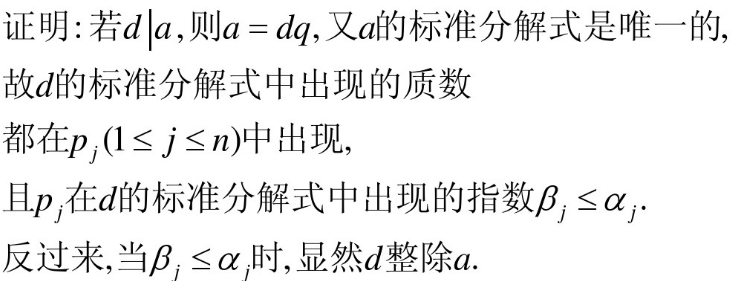素数是数论的核心
整数p>1是素数,当且仅当它的因子只有±1和±p.
介绍算术基本定理:
简单copy一下:https://wenku.baidu.com/view/d0a116035acfa1c7ab00cc69.html
数论基本定理
定理1:

证明:

定理2:

证明:

推论:

证明:

定理3:

证明:

定理4:(算术基本定理)

这种表达是唯一的
证明:


推论1:

证明:

推论2:

费马定理+欧拉定理
费马定理:
若p是素数,a是正整数且不能被p整除,则:
ap-1 ≡ 1 (mod p)
欧拉函数Φ(n):
Φ(n)是小于n且与n互素的正整数的个数。
函欧拉定理:
对于任何互素的a和n,有
aΦ(n) ≡ 1 (mod n)
素性测试
许多密码算法都需要随机选择一个或者多个非常非常大的素数。
我们需要有一种方法测定一个确定的数是否是素数。===> 素性测试 下面给出两个方法 简单的测试和Rabin-Miller算法:
简单的测试算法:
# Prime Number Sieve # http://inventwithpython.com/hacking (BSD Licensed) import math def isPrime(num): # Returns True if num is a prime number, otherwise False. # Note: Generally, isPrime() is slower than primeSieve(). # all numbers less than 2 are not prime if num < 2: return False # see if num is divisible by any number up to the square root of num for i in range(2, int(math.sqrt(num)) + 1): if num % i == 0: return False return True def primeSieve(sieveSize): # Returns a list of prime numbers calculated using # the Sieve of Eratosthenes algorithm. sieve = [True] * sieveSize sieve[0] = False # zero and one are not prime numbers sieve[1] = False # create the sieve for i in range(2, int(math.sqrt(sieveSize)) + 1): pointer = i * 2 while pointer < sieveSize: sieve[pointer] = False pointer += i # compile the list of primes primes = [] for i in range(sieveSize): if sieve[i] == True: primes.append(i) return primes
isPrime(num)
primeSieve(sieveSize)
利用埃拉托色尼(Eratosthenes)筛选法

2.把1标记为非质数
3.把所有2的倍数(除了2本身)标记为非质数
4.把所有3的倍数(除了3本身)标记为非质数
5.把所有4的倍数(除了4本身)标记为非质数
重复该过程
直到8为止(为什么是8? 答:int(math.sqrt(50) = 8)

做完了这些,我们可以看到,表格中留白的都是质数。
但是这个简单的算法是有局限性的,对于大的数时,就略显乏力了
著名的 Rabin-Miller算法:
背景:
n≥3的整奇数n可以表示为:
n-1 = 2kq 其中:k>0, q是奇数,n-1是个偶数!
素数第一性质:
若p是素数,a是小于p的正整数,则 a2 mod p = 1, 当且仅当
a mod p = 1 或者 a mod p = -1 mod p = p -1
素数第二性质:
设p是大于2的素数(p.s. 肯定是个奇数,满足p-1 = 2kq, 其中:k>0, q是奇数); 设a是整数且1<a<p-1,则必有下面两个条件之一成立:
- aq 模 p 和 1 同余, 即 aq mod p = 1 或者说: aq ≡ 1(mod p)
- 整数 aq, a2q, a4q, ... , a2^(k-1)·q中存在一个数, 模p时和-1同余。
详细的算法
- 找出整数k, q, 其中 k>0, q是奇数, 使(n-1 = 2kq );
- 随机选取整数a, 1<a<n-1;
- if aq mod n = 1, then 返回 不确定;
- for j=0 to k-1 do:
- if a2jq mod n = n-1 ,then 返回 不确定
- 返回"合数"
重复使用Rabin-Miller算法:提高“不确定”的可信度
选择多个(t)不同的整数a,他们都能通过测试(返回不确定)的概率小于(1/4)t p.s. 某篇论文证明的哈哈哈哈哈哈
因此,取足够大的t,如果Miller测试总是返回“不确定”, 我们能以很大的把握说n是素数。
# Primality Testing with the Rabin-Miller Algorithm # http://inventwithpython.com/hacking (BSD Licensed) import random # 测试是不是质数的算法主体 . def rabinMiller(num): # Returns True if num is a prime number. # 找出整数t, s, 其中 t>0, q是奇数, 使 n-1 = (2^t)*s ; s = num - 1 t = 0 while s % 2 == 0: # keep halving s until it is even (and use t # to count how many times we halve s) s = s // 2 t += 1 # 随机选取整数a, 1<a<n-1;选择不同的a的次数越多,就越准确地‘判断’ for trials in range(5): # try to falsify num's primality 5 times # random.randrange的函数原型为:random.randrange([start], stop[, step]),从指定范围内,按指定基数递增的集合中 获取一个随机数。 a = random.randrange(2, num - 1) # 函数是计算 x 的 y 次方,如果 z 在存在,则再对结果进行取模,其结果等效于 pow(x,y) %z v = pow(a, s, num) # if a^s mod num = 1, then if不进入返回 一次 不确定; if v != 1: # this test does not apply if v is 1. i = 0 while v != (num - 1): if i == t - 1: return False else: i = i + 1 v = (v ** 2) % num return True def isPrime(num): # Return True if num is a prime number. This function does a quicker # prime number check before calling rabinMiller(). if (num < 2): return False # 0, 1, and negative numbers are not prime # About 1/3 of the time we can quickly determine if num is not prime # by dividing by the first few dozen prime numbers. This is quicker # than rabinMiller(), but unlike rabinMiller() is not guaranteed to # prove that a number is prime. lowPrimes = [2, 3, 5, 7, 11, 13, 17, 19, 23, 29, 31, 37, 41, 43, 47, 53, 59, 61, 67, 71, 73, 79, 83, 89, 97, 101, 103, 107, 109, 113, 127, 131, 137, 139, 149, 151, 157, 163, 167, 173, 179, 181, 191, 193, 197, 199, 211, 223, 227, 229, 233, 239, 241, 251, 257, 263, 269, 271, 277, 281, 283, 293, 307, 311, 313, 317, 331, 337, 347, 349, 353, 359, 367, 373, 379, 383, 389, 397, 401, 409, 419, 421, 431, 433, 439, 443, 449, 457, 461, 463, 467, 479, 487, 491, 499, 503, 509, 521, 523, 541, 547, 557, 563, 569, 571, 577, 587, 593, 599, 601, 607, 613, 617, 619, 631, 641, 643, 647, 653, 659, 661, 673, 677, 683, 691, 701, 709, 719, 727, 733, 739, 743, 751, 757, 761, 769, 773, 787, 797, 809, 811, 821, 823, 827, 829, 839, 853, 857, 859, 863, 877, 881, 883, 887, 907, 911, 919, 929, 937, 941, 947, 953, 967, 971, 977, 983, 991, 997] if num in lowPrimes: return True # See if any of the low prime numbers can divide num for prime in lowPrimes: if (num % prime == 0): return False # If all else fails, call rabinMiller() to determine if num is a prime. return rabinMiller(num) def generateLargePrime(keysize=1024): # Return a random prime number of keysize bits in size. while True: num = random.randrange(2**(keysize-1), 2**(keysize)) if isPrime(num): return num